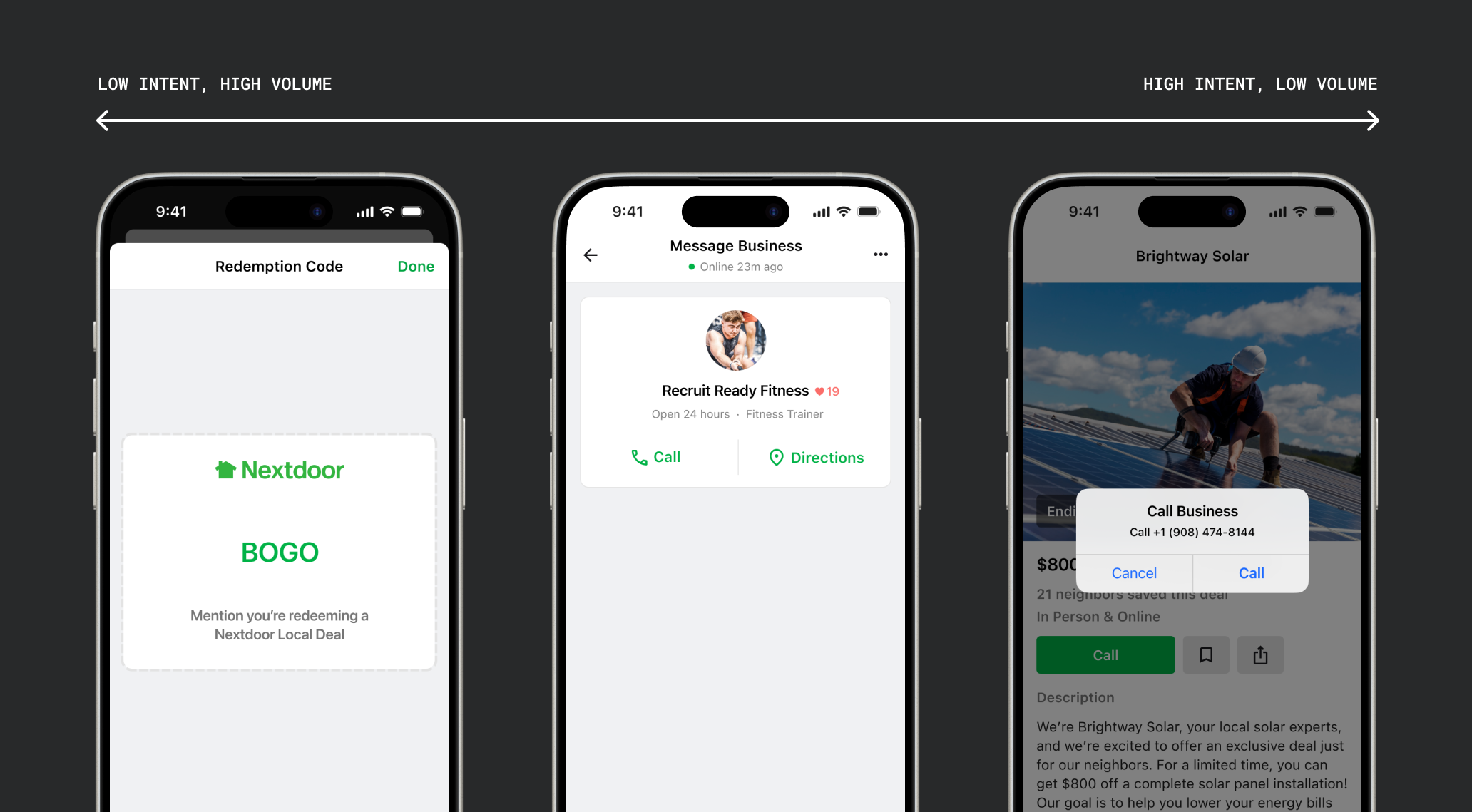Local Deals on Nextdoor
Building a hyperlocal ad platform for small businesses
Timeline
PLATFORM
12 months
Web, iOS & Android
Tags
TYPE
0 to 1 Product Development, Growth Design
Consumer B2B2C
Context
How could we build a meaningful way for local businesses to advertise on Nextdoor?
Nextdoor is the social network for neighborhoods. For years, Nextdoor catered exclusively to neighbors and offered very few tools for local businesses. Commercial content from users became banned due to the overwhelming volume and the risk of spam. This blanket restriction affected all businesses and not just retailers, restaurants and contractors but also dog walkers, music teachers or any individual attempting to promote their services to the community. My team (Local Business) was created to address core platform issues and to reframe SMBs as an opportunity rather than a risk.
Impact
3x predicted ARR — $3M in revenue within 12 months
Launched in US, Canada and UK
As of Q2 2024, self service advertising comprises 48% of Nextdoor’s overall revenue
Success of this project led to complete redesign of our top-of-funnel business acquisition flow
If you’d like to learn more about this case study, please get in touch!
Discovery & market sizing
I started by working closely with data science to do a semantic analysis of the thousands of flagged commercial posts which gave us some signal to find product market fit. We also interviewed small business owners across the country to get a sense of their existing advertising toolset and to zero in on needs. We built out a rapid bare-bones prototype and launched in one market in Austin, Texas to quickly learn from businesses and observe reactions from neighbors. From this, I designed a suite of content management and ad targeting tools for SMBs, as well as a discovery and redemption feedback loop for users.
Figuring out where to focus — Looking at newsfeed content volume, we identified top business verticals to inform our MVP direction
Building the core feedback loop for neighbors
Experience for members comprises of discovery, redemption and reengagement. Members can find deals in the newsfeed, search and on business pages. They can then save it for later and redeem it in-person or online. Key considerations involved creating a powerful feedback loop, personalization and contextual location based notifications.
The first version of our redemption experience was really tailored for restaurants and physical retail stores. In our paid pilot we saw significant interest from home services categories where redemption may not happen in brick and mortar locations and may not have a discount code. I spent time tailoring the redemption experience based on business vertical type and whether deals were low, medium or high consideration. It was a unique challenge to build a digital product that had important physical touchpoints.
Carousel View — Flexible way to merchandize multiple deals in one Newsfeed slot
Designing for scale that elevate business segmentation
After our MVP launch, we began exploring ways to create more tailored flows for different segments of our business users. We received significant feedback from non-retail businesses that our standard redemption model wasn’t quite effective for higher-consideration, lower-volume cases, which are crucial as they often represent higher-spend customers. I designed custom redemption flows that are better adapted per vertical, across online and in-person deals.
Redemption View — Optimized for in-person retail, a large redemption code and a call to action to mention ‘Nextdoor’ is a reaction to businesses indexing on ‘word of mouth’ as a metric of ad effectiveness
Building advertising tools tailored for small businesses
We learnt through on site observation and data analysis that smaller merchants have very little time to make high quality creative. We saw frequent typos, low resolution images or basic punctuation mistakes. I proposed to my team an inline contextual guidance system that captured and corrected mistakes in real time. Key considerations included automating manual workflows, delivering meaningful analytics and supporting businesses in creating engaging content.
Neighborhood level targeting is an unique selling point of Local Deals. After several iterations, I came to a radius-based design that is simple to understand and flexible. More importantly it enabled us to customize a default order size based on the type of business. This new design directly resulted in a 2.5x increase in our average order value.
Contextual Guidance — Improved content quality and reduced user error
Audience Targeting — A slider based design that controls a radius which enabled fast, efficient and flexible targeting that is performant on web and on mobile






